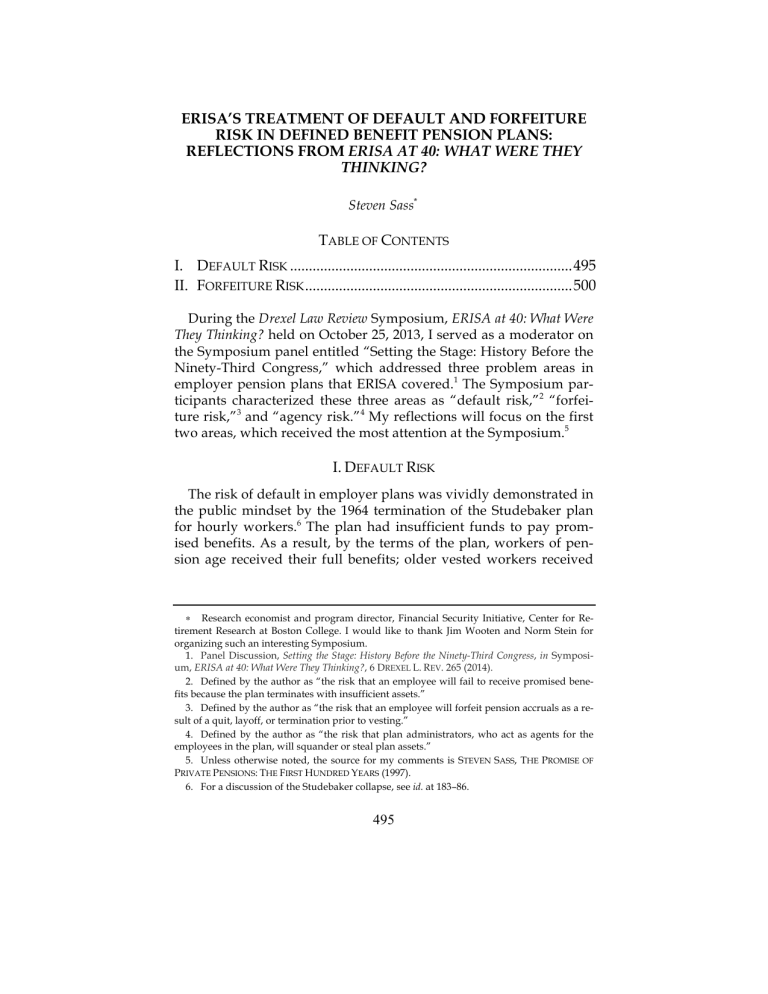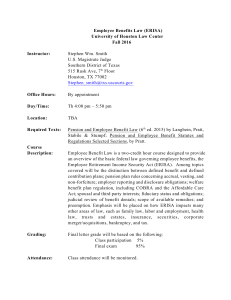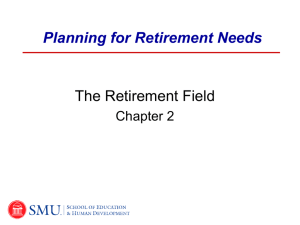ERISA’S TREATMENT OF DEFAULT AND FORFEITURE
advertisement

ERISA’S TREATMENT OF DEFAULT AND FORFEITURE RISK IN DEFINED BENEFIT PENSION PLANS: REFLECTIONS FROM ERISA AT 40: WHAT WERE THEY THINKING? Steven Sass* ∗ TABLE OF CONTENTS I. DEFAULT RISK ........................................................................... 495 II. FORFEITURE RISK ....................................................................... 500 During the Drexel Law Review Symposium, ERISA at 40: What Were They Thinking? held on October 25, 2013, I served as a moderator on the Symposium panel entitled “Setting the Stage: History Before the Ninety-Third Congress,” which addressed three problem areas in employer pension plans that ERISA covered.1 The Symposium participants characterized these three areas as “default risk,”2 “forfeiture risk,”3 and “agency risk.”4 My reflections will focus on the first two areas, which received the most attention at the Symposium.5 I. DEFAULT RISK The risk of default in employer plans was vividly demonstrated in the public mindset by the 1964 termination of the Studebaker plan for hourly workers.6 The plan had insufficient funds to pay promised benefits. As a result, by the terms of the plan, workers of pension age received their full benefits; older vested workers received ∗- Research economist and program director, Financial Security Initiative, Center for Retirement Research at Boston College. I would like to thank Jim Wooten and Norm Stein for organizing such an interesting Symposium. 1. Panel Discussion, Setting the Stage: History Before the Ninety-Third Congress, in Symposium, ERISA at 40: What Were They Thinking?, 6 DREXEL L. REV. 265 (2014). 2. Defined by the author as “the risk that an employee will fail to receive promised benefits because the plan terminates with insufficient assets.” 3. Defined by the author as “the risk that an employee will forfeit pension accruals as a result of a quit, layoff, or termination prior to vesting.” 4. Defined by the author as “the risk that plan administrators, who act as agents for the employees in the plan, will squander or steal plan assets.” 5. Unless otherwise noted, the source for my comments is STEVEN SASS, THE PROMISE OF PRIVATE PENSIONS: THE FIRST HUNDRED YEARS (1997). 6. For a discussion of the Studebaker collapse, see id. at 183–86. 495 496 DREXEL LAW REVIEW [Vol. 6:495 fifteen cents on the dollar; and the rest of the Studebaker workforce received nothing. Funding shortfalls—having insufficient assets to meet plan obligations—were not uncommon, but were the condition of many preERISA plans. Employer defined benefit pension plans, in fact, are the only financial institution of which I know that are allowed to remain in existence if insolvent with assets insufficient to meet their obligations. Most employer pension plans begin totally insolvent, as they promise workers benefits based on past service before the employer contributes the first dollar to the pension fund. This was especially true for collectively bargained plans established after the Second World War; these plans granted benefits to workers who had lived through the Depression and post-war inflation so they could retire on a reasonable pension.7 The pre-ERISA minimum funding rules—the rules the government required for the plan to gain favorable tax treatment—did not require solvency. The Revenue Act of 1942,8 which was the key legislation regulating employer plans prior to ERISA, did not require sponsors to contribute an amount sufficient to pay the plan’s promised benefits. To qualify for favorable tax treatment, the Act required sponsors to contribute just the plan’s “normal cost,” the cost of benefits workers earned that year, and to freeze the cost of benefits based on the worker’s past service to pay just the interest on the plan’s past service obligation. Thus, the pre-ERISA funding rules not only allowed plans to be insolvent, but also allowed plans to remain permanently insolvent. Should a plan that followed the minimum funding rules terminate, it would precipitate a Studebakertype outcome. “Best-practice” in pre-ERISA pension management was more stringent. It called for sponsors to pay down their past service obligation over a thirty-year period. The notion was that in time, plans would be fully funded and only actuarial gains and losses9 would affect plan solvency. “Best-practice” funding rules required sponsors to eliminate actuarial losses within fifteen years. Studebaker had not funded its plan at the government’s minimum required contribution, but followed the “best-practice” funding program. When the Studebaker plan terminated, it nevertheless left many workers 7. See id. at 117–19. 8. Revenue Act of 1942, Pub. L. No. 77-753, 56 Stat. 798. 9. Defined by the author as “fluctuations in the plan’s funded status due to changes in asset prices and interest rates.” 2014] TREATMENT OF DEFAULT AND FORFEITURE RISK 497 with little to none of the pension benefits that they had earned according to the terms of the plan, which they would need in retirement. Studebaker was by far the best-known illustration of default risk in pre-ERISA pension plans. But the more stringent funding requirements that ERISA put in place were precisely the “bestpractice” funding rules that Studebaker had used. Requiring contemporary “best-practice” funding rules eliminated objections from the large number of responsible sponsors that had adopted this funding program. The past-service obligations that a large number of post-war plans assumed—often still far from fully funded in 1964—were in many cases largely paid off by 1974, justifying the thirty-year amortization rule. Unfunded past-service obligations, however, remained a serious problem in collectively bargained plans. The pension benefits these plans pay out are set in collective bargaining agreements, and are typically defined as a specific dollar amount for each year of service. As each collective bargaining agreement typically raises the dollarsper-hour paid out in wages, it also typically raises the dollars-peryear-of-service that the pension plan pays out. These increases create a new past-service obligation based on the increase in the dollar amount that the plan pays out for each year of past service. Thus, bargained plans that pay down their past-service obligations over a thirty-year period will never pay down their past-service obligations.10 This is not the case for non-bargained plans that typically define pension benefits as a percentage of final salary multiplied by years of service. Their funding program projects final salaries— which do not systematically rise over time—so their past-service obligations do not systematically rise over time, and non-bargained plans can expect to pay it down. At the time ERISA was enacted, the funding problem in collectively bargained pension plans was exacerbated by the rise of early retirement. Many bargained plans had allowed workers with thirty years of service to retire early, for example, at age sixty or sixty-two, on full benefits without any actuarial adjustment. However, very few workers had retired early, believing the income provided by Social Security and a full employer pension to be too low to meet their needs. This calculation changed with the expansion of government benefits for the elderly in the years leading to the enactment of ERISA, an expansion that included the enactment of Medicare in 1965 and culminated in the 1972 increase in Social Security bene10. See Robert C. Kryvicky, The Funding of Negotiated Pension Plans, 33 TRANSACTIONS SOC’Y ACTUARIES, 405, 430 (1981). 498 DREXEL LAW REVIEW [Vol. 6:495 fits.11 Early retirement suddenly became attractive to large numbers of union workers. This not only increased pension costs, adding years of full benefit receipt, but also made ERISA’s thirty-year funding of past service obligations increasingly incapable of moving these plans to solvency. As fresh past-service obligations materialized at each contract re-negotiation, all but the youngest workers would be retired before these new obligations were fully funded. ERISA’s minimum-funding rules thus did little to reduce default risk in employer pension plans. But the legislation introduced two other innovations that addressed this risk. ERISA made employers liable for funding shortfalls up to 30% of their net worth. It also created the Pension Benefit Guaranty Corporation (PBGC) that insured pension benefits, up to a specified amount, should a plan’s assets and the contingent claim on the sponsor prove insufficient to pay promised benefits. ERISA’s contingent claim on the sponsor also proved ineffective. When plans terminate with insufficient assets, sponsors are typically insolvent or are on the edge of insolvency with little or no net worth, as in the case of Studebaker. What might have been a missed opportunity was for ERISA to include the contingent claim when assessing the plan’s funded status. For example, ERISA might have required more than full funding when including this contingent claim, and might have specified various remedial actions should the assets in the pension fund, plus this claim on the sponsor, be inadequate. For example, the government could have required plans to be 150% funded, with two dollars of the sponsor’s market value counted as one dollar in this valuation, with stepped-up contributions required should funding fall below that benchmark. Pension insurance was ERISA’s other approach to default risk.12 As various Symposium presenters made clear—presenters who were active participants in the legislative process that produced ERISA—pension insurance was at the top of the labor reform agenda.13 Union officials understood the limited effectiveness of the new funding rules and of contingent claims on the sponsor in reducing 11. SASS, supra note 5, at 231–32. 12. See id. at 207–13. 13. Remarks of Daniel I. Halperin, in Panel Discussion, Setting the Stage: History Before the Ninety-Third Congress, in Symposium: ERISA at 40: What Were They Thinking?, 6 DREXEL L. REV. 265, 275 (2014); Remarks of Frank Cummings, in Panel Discussion, Setting the Stage: History Before the Ninety-Third Congress, in Symposium: ERISA at 40: What Were They Thinking?, 6 DREXEL L. REV. 265, 287 (2014); Remarks of Jack Sheehan, in Panel Discussion: Making Sausage: The Ninety-Third Congress and ERISA, in Symposium: ERISA at 40: What Were They Thinking?, 6 DREXEL L. REV. 291, 298–300 (2014). 2014] TREATMENT OF DEFAULT AND FORFEITURE RISK 499 default risk in their plans. Thus, union officials favored a government pension insurance program. My sense from the comments of the Symposium presenters was that others involved in the legislative process were not attuned to the magnitude of default risk in collectively bargained plans. Some were anxious about the moral hazard in the new insurance program. But few understood the ineffectiveness of ERISA’s funding rules and claims on the sponsor’s net worth in reducing the risk that the PBGC would insure. In hindsight, it is clear that ERISA seriously underestimated both the magnitude of default risk in employer plans and the ability of its new funding rules and contingent claims to reduce that risk. The result has been very large pension obligations transferred to the PBGC. This, in turn, produced ever more stringent contribution requirements in the event of funding shortfalls, in an effort to limit the pension obligations the PBGC might need to absorb. And these stringent contribution requirements became an important factor in the dramatic reduction of traditional defined benefit plans since the turn of the twenty-first century. Up until the turn of the century, the shift in employer plan coverage from defined benefit pensions to defined contribution savings programs was largely due to new sponsors adopting 401(k) plans. Large sponsors that had defined benefit plans generally maintained their programs over the quarter century following the enactment of ERISA. But by the turn of the century these plans had matured—the number of participants who had retired or who were approaching retirement had swelled relative to the number of younger workers— and the size of their obligations grew large relative to the net worth of the sponsor. Then, financial markets were hit by the dot-com crash. Large pension funding shortfalls emerged as falling equity prices reduced the value of plan assets, and as falling interest rates increased the present value of plan obligations. The stringent funding rules imposed to protect the PBGC required a three-fold increase in pension contributions at the very time that sponsors found it especially challenging to come up with the cash. Given this untimely spike in required contributions, sponsoring a defined benefit pension plan suddenly became a very risky proposition. This riskiness, perhaps even more than the rising long-term cost of a plan, seems to have been a major reason why sponsors have frozen or shut down their plans since the turn of the century.14 14. See ALICIA H. MUNNELL & STEVEN A. SASS, SOCIAL SECURITY AND THE STOCK MARKET: HOW THE PURSUIT OF MARKET MAGIC SHAPES THE SYSTEM 141(2006). 500 DREXEL LAW REVIEW [Vol. 6:495 II. FORFEITURE RISK The second major problem ERISA addressed was forfeiture risk— the risk that workers might forfeit their accrued pension benefits by failing to meet the plan’s vesting requirements. Forfeiture risk raised two issues. The first was fairness. Workers suffered serious financial harm when denied pensions—whether due to a layoff, sudden health shock, or a short break in service. Whatever the legalities or terms of the plan, such forfeitures seemed grossly unfair. The second issue was the reduction in public benefits received in exchange for the favorable tax treatment provided to employer pension plans. The pensions provided to rank-and-file workers were the public benefits intended to supplement what they received from Social Security. This concern with pension forfeitures first emerged in the late 1930s. Officials in the Treasury Department then took note that small-business owners were using employer pension plans with onerous vesting requirements as a personal tax avoidance device.15 This led to the anti-discrimination requirements in the Revenue Act of 1942, which limited tax benefits to plans that could be reasonably expected to provide pensions to rank-and-file workers.16 In order to enforce these anti-discrimination provisions, the Internal Revenue Service examined a plan’s vesting requirements and the likelihood of forfeitures among rank-and-file workers, commonly considering twenty years of service as a safe-harbor vesting requirement. By the early 1970s, the employer pension institution had expanded to cover nearly half of all U.S. workers.17 The government’s foregone tax receipts—now called tax expenditures—were greater than its tax expenditure on any other item, including mortgage interest payments. Treasury Department officials again questioned whether the government was getting sufficient public benefits in exchange for these expenditures. To justify the large amount of foregone revenue, officials sought to reduce pension forfeitures by imposing more stringent vesting requirements so that a greater share of U.S. workers could retire with at least a small employer pension. From discussions at the Symposium, it seems that Congress viewed forfeiture risk largely as an issue of fairness, and enacted ERISA’s vesting requirements in response. The Treasury’s public 15. Nancy J. Altman, Rethinking Retirement Income Policies: Nondiscrimination, Integration, and the Quest for Worker Security, 42 TAX L. REV. 435, 450–51 (1987). 16. Revenue Act of 1942, Pub. L. No. 77-753, 56 Stat. 798. 17. See SASS, supra note 5, at 215. 2014] TREATMENT OF DEFAULT AND FORFEITURE RISK 501 benefits perspective, however, proved important to the administration of the new law. The IRS, as part of the Treasury Department, had been the primary government regulator of employer pension plans. The IRS had used its power to police tax avoidance to assure conformity with statutory requirements, such as the requirement that plans benefit workers as a group in order to qualify for tax preferences. ERISA divided the primary regulatory responsibilities between the Treasury and Labor Departments without specifying how these responsibilities would be shared. The presenters at the Symposium reported an extremely harmonious division of responsibilities, which one presenter attributed to the Treasury Department’s public benefits perspective.18 Treasury officials responsible for employer pensions effectively balanced the IRS’s traditional focus on collecting taxes with a concern for increasing employer pensions for rank-and-file workers.19 ERISA’s approach to reducing forfeiture risk has, nevertheless, been largely rendered moot. ERISA’s approach required faster vesting as a quid pro quo for the government’s pension tax favors. The wholesale shift from employer defined benefit pension plans to 401(k) plans and the sharp decline in marginal tax rates since 1974 rendered this approach moot. The shift to 401(k) plans dramatically reduced forfeiture risk because 401(k) balances are typically vested immediately or vested within a short period of time. The rise in 401(k) plans, despite the sharp decline in marginal tax rates, also suggests that the government’s pension tax expenditures did not need to be nearly as large to induce employers to offer plans with desired public benefits. It could be the case that defined benefit plans, which are riskier and generally more expensive for employers, require a larger quid pro quo than does a 401(k). But it could also be the case that ERISA’s approach offered too much for too little.20 18. After the panel concluded, I asked Mark Iwry if this “extremely harmonious division of responsibilities” could be attributed to the Treasury Department’s public benefits perspective. Mr. Iwry responded enthusiastically that this was the case. 19. See generally Remarks of Mark Iwry, in Panel Discussion, Negotiating the Agency Peace Treaty: Reorganization Plan No. 4, in Symposium: ERISA at 40: What Were They Thinking?, 6 DREXEL L. REV. 319 (2014). 20. See Raj Chetty, John N. Friedman, Soren Leth-Petersen, Torben Heien Nielsen & Tore Olsen, Subsidies vs. Nudges: Which Policies Increase Saving the Most?, 13-3 CENTER FOR RETIREMENT RES. BOSTON C. 1, 5 (2013).






